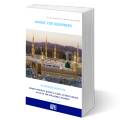
The Hanafi madhab stands as one of the four primary Sunni schools of Islamic jurisprudence, leaving an indelible mark on the intellectual and spiritual landscape of the Muslim world. In this piece, we delve deep into this school, tracing its roots to its modern-day relevance.
The school is named after its founder, Imam Abu Hanifa an-Nu’man ibn Thabit, who hailed from Kufa, Iraq. The backdrop of its formation is vital: the 8th-century Muslim world was a melting pot of ideas, with Kufa being a major hub of scholarship, hosting scholars from diverse backgrounds.
Abu Hanifa was a profoundly original thinker. His approach leaned heavily on intellectual engagement, debate, and an openness to varied opinions. His scholarship birthed a vibrant jurisprudence tradition, later enriched by his primary disciples, like Abu Yusuf and Muhammad al-Shaybani.
Several elements distinguish the Hanafi madhab:
Ra’y (Personal Opinion): Unlike some other schools, Hanafi emphasizes personal opinion, showcasing trust in human interpretative capacity, while still anchoring to the sacred texts.
Maslaha (Public Interest): The well-being of the community always takes center stage, underlining the importance of public interest.
Qiyas (Analogical Reasoning): For novel situations, qiyas is employed to derive judgments based on similar cases previously addressed in the sacred texts.
The influence of the Hanafi school extended beyond just Kufa or Iraq. Through Abu Hanifa’s students and its endorsement by Muslim rulers, notably the Ottoman Empire, Hanafism spread. With the Ottomans adopting Hanafism as their official school of law, its reach expanded from Southeast Europe to Asia Minor and beyond.
Theology: Beyond jurisprudence, Abu Hanifa also shaped Muslim theology. His discourses on intricate matters, like the nature of faith and deeds, molded Islamic thought.
Finance and Economy: Adapting to an ever-changing world, the Hanafi school crafted intricate regulations concerning economic matters, influencing trade, finance, and business ethics.
Culture and Education: Hanafi educational institutions thrived, nurturing generations of Muslims across various fields, from theology to philosophy.
Today, the Hanafi madhab remains salient. Its adaptive nature positions it to address contemporary challenges. For instance, modern Hanafi scholars tackle issues like women’s rights, current financial matters, and bioethics, drawing from their school’s deep traditions.
With its rich history, distinctive methodology, and broad influence, the Hanafi madhab stands as a cornerstone of Islamic jurisprudence. It exemplifies the diversity and opulence of Islamic thought, illustrating how tradition and modernity can harmoniously coexist in the Muslim realm.
To Know More: Understanding the Madhab – Islamic Jurisprudence Schools
Discover the experiences of our delighted clients who have thoroughly enjoyed utilizing this standout feature.
Alhamdulillah I‘m very pleased with the arabic and Qur’an lessons I receive from teacher Umm Tasneem and I‘m also content with the al-dirassa administration team who were very quick in answering any questions I had. In a month I progressed a lot and I cannot wait to continue my studies with al-dirassa. May Allah reward everyone at al-dirassa.
Verified review - view original
My Qur’an teacher is fantastic, she teaches me in a loving and kind way where I look forward to the lessons and learn so much. My Arabic teacher is equally as nice and has a lot of patience with me, she has great expertise in the field and I’ve progressed really quickly with her. Thank you Al-dirassa!
Verified review - view original
Don’t want to go through the translation anymore?
30 free minutes with your qualified Egyptian teacher.

Al-dirassa Institute offers you a gift to help you begin your journey to being fluent in Arabic and learning the Quran.

Al-dirassa Institute offers you a gift to help you begin your journey to being fluent in Arabic and learning the Quran.